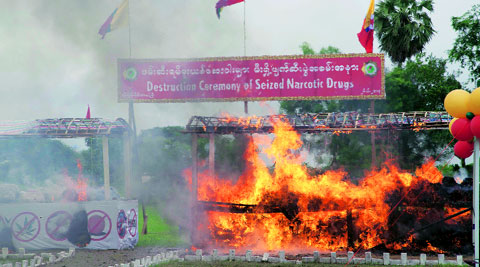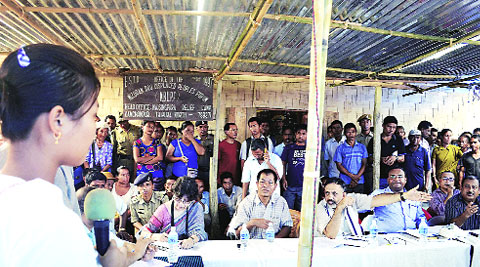Shops, offices and educational institutions are open in
Assam's Golaghat town as it limps back to normalcy after witnessing
major clashes between civilians and police on 20 August resulting in the
death of three people and many injured.
Ironically, the clashes happened during a protest against police
excess. At the core of these clashes was the Assam-Nagaland border
turmoil which got sidelined because the attention shifted to police
violence rather than on the contentious border issue.
Today, 780 families of 16 villages at Sector 'B' at Uriamghat in
Assam's Golaghat district, whose houses were burnt down by NSCN-KK
cadres who illegally crossed over to Assam, lead an uncertain life at
the ill-equipped relief camps. They stare at a bleak future as the state
government provides no solid assurance to secure them, and their homes
have already been destroyed. As of now, they do not have the courage to
return to their homes because they fear being targeted by Naga
insurgents.
In their latest wave of attack, 16 people lost their lives. This is
not first time that Assam has lost its people to Naga miscreants. In two
big attacks in January 1979 and in June 1985, Naga militants. allegedly
with support from the Nagaland Police killed nearly 100 people in the
Golaghat district including Assam Police personnel.

Shops get opened after curfew was relaxed from 6 am to 12 noon in tension-gripped Golaghat on Friday. PTI
Officially, Assam and Nagaland share a 434 km boundary after the
latter was carved out as an independent state in 1963. However, Nagaland
has been encroaching on vast swathes of land in the upper Assam
districts of Sivasagar, Jorhat and Golaghat since then. Over 60,000
hectares of Assam forest land is under the occupation of Nagaland where
schools, health centres, churches and other facilities have sprung up
with the direct help of the Naga government. Violence is used a method
to scare away the residents after which a methodical occupation begins.
Helpless in front of the aggressive Nagas and owing to Nagaland's
refusal to accept the constitutional boundary, Assam has also knocked on
the doors of the Supreme Court but the verdict is still awaited.
"Both the Centre-appointed Sundaram Commission (1971) and the Shastri
Commission (1985) had ruled in favour of Assam. But Nagaland rejected
the recommendations of both these panels. For administrative
convenience, the Britishers had way back in 1925 demarcated a boundary
between Assam and Nagaland. But Nagaland started behaving aggressively
after the state was formed in 1963. The first clash happened at Assam's
Kakodoonga Reserve Forest in 1965," professor in Sociology, Tezpur
University Chandan Kumar Sharma told
Firstpost.
Different bodies in Nagaland often refer to history to fortify their
claim on the land that officially belongs to Assam. But the reference to
history is hotly contested.
"The Nagas are seeking a historical boundary but there is no evidence
to prove it. The Ahom kings gave land to Nagas for agriculture but the
ownership of the land always belonged to the state. During the Ahom
rule, the Nagas were entrusted with the responsibility to look after
peace in areas which were located further south of the Ahom capital.
There is no documentation on the basis of which Nagaland can claim the
land as theirs. The border in the days of Ahom rule was not a hard
(fixed) one. It was converted into a hard one from soft by the
Britishers (in 1925)," Sharma said.
In a memorandum
submitted to the Supreme Court-appointed Local Commission on
Assam-Nagaland border issue on 20 August 2007, the All Assam Students’
Union (Aasu) also came down heavily on the historical "distortion" of
boundary the Nagas were carrying out. It said: "
Every year the Naga
chiefs with large revenue came down to the Ahom capital to pay tribute.
It was then only the Nagas would enjoy products of the khats (land).
Unless they came and paid tribute in kind to the Ahom kings, the Naga
chiefs were not entitled to enjoy the khat and fishing lake. A
refractory chief was not allowed to come down and thus he forfeited the
products of the khats. According to the British records, there had been
some 25 khats along the foot of the Naga Hills but within the Ahom
kingdom.
"
It is unfortunate that the Nagas have distorted this historical
fact by explaining the khats as "taxes" paid by the Ahom kings, whereas
the khats were landed estates, granted by Ahom kings to certain villages
or clans of Naga in consideration of services. The khats were
cultivated by a class of men called paik who were subjects of the Ahom
kings. Even during the British period, the khats were treated as valid
revenue grants and were still cultivated by tenants. However, these were
managed by the Katakis. These katakis were employed by the British
officials as intermediaries in their dealing with the Nagas. In the Ahom
period, the Katakis were appointed by the Ahom king. During the British
period, the Katakis were appointed by the British. All Katakis were
Assamese, not Nagas."
Assam's border plight is not limited to Nagaland alone. Clashes are
also common on the Assam-Meghalaya and Assam-Arunachal Pradesh border.
On 29 January this year, armed groups from Arunachal Pradesh attacked
Chauldhuwa village at Behali Reserve Forest village in Assam's Sonitpur
district killing 10 people and injuring eight. Major clashes also
occurred at the Assam-Meghalya border in January 2011. The state also
shares its boundary with Manipur, Mizoram and Tripura.
Border conflicts that Assam has with most of its neighbours is due to
the fact that all these new Indian states belonged to the erstwhile
Assam Province. It was created by the British in 1911 after the
partition of the Eastern Bengal and Assam Provinces. Shillong was the
Assam capital before Meghalaya became a separate state. Assam was first
separated from Bengal in 1874 as per the 'North-East Frontier'
non-regulation province by the British. Then it became a part of Eastern
Bengal in 1905 and became an independent province in 1911.
"Before these hard boundaries were set up to collect tax, the natural
resources on the border areas were all common," Sharma said.
"The Britishers began tea plantation in a massive way by destroying
vast forest areas. The tea gardens were prohibited areas and no
trespassing was allowed. In fact, this was the first step that
disconnected the Naga tribes living on the hills from the rest of the
population on the plains as the tea gardens blocked most of the paths
which were in use to transit between the hills and plains for
generations," he said.
Not only had the tea gardens created a gap between the hills and
plains but they also made the Nagas realise that by owning tea gardens
they had the chance of becoming farm-based entrepreneurs. What the Nagas
have been eyeing for decades are also profits from tea farming.
Geographically speaking, Nagaland is cradled on the Naga Hills which are
part of the Arakan range or Rahkine range. Due to the hilly terrain,
farming has always been a challenge on the slopes. In this context, tea
cultivation has also made the ongoing Assam-Nagaland border strife an
economic one. In fact, many small and illegal tea gardens have already
come up in the disputed region under Naga ownership.

Security personnel patrol in the streets of tension-gripped Golaghat town after curfew was extended till 6PM on Friday. PTI
"They are seeking land in the plains. Those who are seeking land in
plains for farming are mostly the elite class in Nagaland. In fact, they
are allegedly using illegal migrants from Bangladesh as cheap labourers
to work in the tea gardens. The Nagas are also shifting their attention
away from their traditional
jhum cultivation," the professor said.
But this practice has come up with its own set of problems. Now the
Bangladeshi population has gradually swelled in the area leading to
confrontations between them and the Nagas regarding ownership of land.
Add to that jobless workers of nearby tea gardens have also settled down
in these places which are largely reserved forests.
"Many Assamese families who live in these reserved areas have lost
their property in some other parts of the state due to recurrent erosion
and floods. As the government has no rehabilitation policy for them,
these people have to fend for themselves," Sharma said.
N Venuh, associate professor in the department of History and
Archaeology, Nagaland University shared a different perception on the
issue.
"The real people of Assam and Nagaland living in the region do not
have any differences on the boundary. It is the increasing number of
Bangladeshi migrants and Adivasi immigrants that is causing the problem.
Earlier these Adivasis were tenants of the Nagas but now that they have
started claiming the land as theirs. Some unscrupulous elements took
advantage of the situation and made it an Assam-Nagaland border
dispute," Venuh told
Firstpost from Lumami in Nagaland's Zunheboto district.
He also blamed the Assam government for allegedly indulging in electoral politics.
"They want these people to settle there and take electoral benefits
out of them. They actually want to protect these people at the expense
of the original Assamese and Naga people who are the original
inhabitants of the region. The real people are very clear about the
boundary. The border dispute has been enforced upon us for political
reasons. No one from Nagaland is encroaching. In 2007, a joint team of
27 civil organisations both from Assam and Nagaland had toured the
entire region and found that there is no dispute on the ground," he
said.
However, Sharma did not agree with Venuh that there is no
encroachment from the Nagaland side. He pointed out that beyond the
economic purview the expansionist mentality of the Nagas, particularly
of its insurgents, has become a reason of great concern for Assam.
"The demand for a Greater Nagalim has only found favour from
successive state governments in Nagaland. It is a fact that the NSCN
cadres, no matter to which faction they belong to, roam freely with
weapons and the Nagaland government conveniently looks away.
Unofficially, it is quite apparent that the Nagaland government is
behind this land gain mission. Unless Assam embarks upon strong policies
to protect its borders from encroachments, this would continue
unabated. There is also need to stop the appeasement policy towards
Nagaland. It is still unbelievable that Assam gifted Dimapur to Nagaland
whereas it rightfully belonged to the Dimasa tribe," Sharma said.
It is obvious that both the states are using the circumstances on the border as per their convenience.
"If the both the governments are sincere to resolve the dispute and
if they take the real people into confidence the problem should be
solved in the future," Venuh said.
But there is a catch. Who are the 'real people'?
































%2BGuwahati.PNG)



